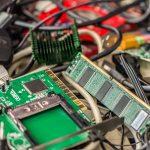
WEEE Recycling has become an increasingly vital part of the waste and recycling industry. This guide, by Reclamet, explains everything you need to know on the subject.
What is WEEE?
‘WEEE’ is an acronym standing for ‘Waste Electric and Electronic Equipment’. This definition applies to all end-of-life electrical and electronic equipment (generally anything with a plug or battery), divided into either household or non-household WEEE.
About WEEE regulations
The Waste Electric and Electronic Equipment Directive (WEEE Directive) first became law in 2003 as part of a European Union (EU) initiative. In essence, it makes the companies who manufacture and distribute such equipment responsible for its disposal.
WEEE regulations were adopted by the UK in 2006, having since been replaced by the Waste Electrical and Electronic Equipment Regulations 2013. This legislation established the requirements for the recovery, recycling, reuse and treatment of WEEE.
Before the WEEE Directive was introduced in the UK, waste electrical and electronic goods were mixed up in municipal/household waste. Since 2006, however, WEEE recycling has become a rapidly-growing sub-sector, ever more essential to the national economy.
Waste electrical items can have a harmful effect on the environment as well as animal and human health. Ultimately, the Directive aims to reduce the potential impacts of WEEE in the landfill by encouraging recycling, minimising waste and incentivising the production of more environmentally-friendly products.
WEEE requirements
The law makes it clear that the producers of electronic and electrical equipment are financially responsible for the environmental impact of goods they place on the market, particularly at the point that those goods become ‘waste’.
Effectively, all producers are therefore required to manage the collection, treatment and recycling of WEEE. To facilitate this, all producers are obliged to register with, or create, a registered compliance scheme.
Failure to follow these waste regulations can result in a fine of up to £5,000, as well as further prosecution.
WEEE recycling standards
There are ten categories outlined in the current version of WEEE legislation. These are:
- Larger household appliances (e.g. fridges, cookers, washing machines)
- Smaller appliances (e.g. vacuum cleaners, irons, toasters)
- IT equipment (e.g. computers, printers, scanners)
- Consumer equipment (e.g. radios, TVs, camcorders)
- Lighting (e.g. lamps, fluorescent tubes)
- Electrical tools (e.g. drills, sewing machines, saws)
- Toys and leisure (e.g. gaming consoles, battery-powered toys, exercise machines)
- Medical devices (e.g. dialysis machines, analysers, medical freezers)
- Monitoring and control equipment (e.g. smoke detectors, thermostats)
- Automatic dispensers (e.g. drink, food and cash dispensers)
However, it is expected that these categories will be expanded at some point in 2019.
How does WEEE recycling work?
Legally obliged to handle their waste in accordance with WEEE regulations, businesses have what is deemed a “duty of care” relating to how WEEE they produce is stored, moved and disposed of. This duty of care applies from the moment the electrical or electronic product is created, through to the moment it is recovered, recycled and/or destroyed.
As WEEE items are often extremely complex, they can be tricky to recycle. The exact treatment of these goods is bound to vary, depending upon the category of WEEE and the technology required to handle them. Indeed, it’s not uncommon for waste electronics to contain a number of hazardous materials, such as arsenic, cadmium, lead and mercury, amongst others.
As a result, it’s required by law that companies responsible for directly recycling WEEE items are experienced and licensed to deal with the materials. Waste collection companies require a Waste Carriers’ Licence, while WEEE recycling, treatment and disposal facilities must be registered as an Approved Authorised Treatment Facility (AATF).
WEEE collection and disposal
It is worth noting that nothing about WEEE regulations imply a company (or obligated producer) must physically dispose of electrical waste themselves. Usually, such arrangements are made during the process of signing up for a registered compliance scheme.
Most organisations choose to fulfill their obligations by arranging for a licensed AATF to manage all aspects of the WEEE recycling process.
Summary
In short, WEEE regulations ensure that businesses must minimise the environmental impact of electrical and electronic equipment they produce. With the UK disposing of over a million tonnes of such equipment every year, it’s essential that goods are recycled and repaired – rather than spilling toxins and other pollutants into landfills.
The WEEE Directive is responsible for massively improved recycling rates for electrical and electronic equipment. As a licensed AATF, Reclamet is more than happy to support this vital industry.
